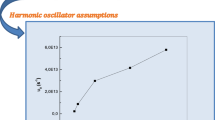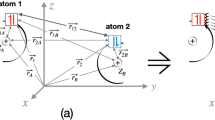Summary
Handy et al. have shown that the asymptotic behavior of Hartree-Fock orbitals is controlled by the energy of highest occupied molecular orbital, except for the atomic case in which onlys-orbitals are occupied. However, their proof is not complete at one point. This point is clarified, and a more unified derivation is given. Further, we discuss the preexponential factorr α of the leading asymptotic termr α exp[−βr], where β=(−2εHOMO)1/2 and εHOMO is the orbital energy of HOMO. New results are obtained for linear molecules, and the results of several authors for atoms and non-linear molecules are reproduced.
Similar content being viewed by others
References
Ohno K, Ishida T (1986) Int J Quantum Chem 29:677–688
Ishida T, Ohno K (1989) Int J Quantum Chem 35:257–266
Ahlrichs R (1972) Chem Phys Lett 15:609–612
Ahlrichs R (1972) Chem Phys Lett 18:521–524
Hoffmann-Ostenhof M, Hoffmann-Ostenhof T (1977) Phys Rev A 16:1782–1785
Hoffmann-Ostenhof T, Hoffmann-Ostenhof M, Ahlrichs R (1978) Phys Rev A 18:328–334
Tal Y (1978) Phys Rev A 18:1781–1783
Katriel J, Davidson ER, Proc Natl Acad Sci USA 77:4403–4406
Ahlrichs R, Hoffmann-Ostenhof M, Hoffmann-Ostenhof T (1981) Phys Rev A 23:2106–2117
Morrell MM, Parr RG, Levy M (1975) J Chem Phys 62:549–554
Ahlrichs R (1976) J Chem Phys 64:2706–2707
Levy M, Parr RG (1976) J Chem Phys 64:2707–2708
Silverstone HJ, Carrol DP, Metzger RM (1979) J Chem Phys 70:5919–5921
Carrol DP, Silverstone HJ, Metzger RM (1979) J Chem Phys 71:4142–4163
Lassettre EN (1976) J Chem Phys 64:4375–4389
Lassettre EN (1979) J Chem Phys 70:3468–3487
Huo WM, Lassettre EN (1980) J Chem Phys 72:2374–2383
Lassettre EN (1981) J Chem Phys 74:1225–1238
Lassettre EN (1985) J Chem Phys 82:827–840
Lassettre EN (1985) J Chem Phys 83:1709–1721
Koga T (1985) J Chem Phys 83:6301–6303
Koga T (1988) J Chem Phys 89:4209–4211
Cassida ME, Chong DP (1989) Chem Phys 132:391–405
Handy NC, Marron MT, Silverstone HJ (1969) Phys Rev 180:45–48
Handler GS, Smith DW, Silverstone HJ (1980) J Chem Phys 73:3936–3938
Davis CL, Jensen HJA, Monkhorst HJ (1984) J Chem Phys 80:840–855
Hobson EW (1955) The Theory of Spherical and Ellipsoidal Harmonics, Chelsea, New York
In Ref. 7, the integral with respect tor′ was treated without dividing integral region. However, the integral region should be divided into 0 tor andr to ∞ according to each Laplace expansion forr′<r andr′>r
Author information
Authors and Affiliations
Rights and permissions
About this article
Cite this article
Ishida, T., Ohno, K. On the asymptotic behavior of Hartree-Fock orbitals. Theoret. Chim. Acta 81, 355–364 (1992). https://doi.org/10.1007/BF01134860
Received:
Revised:
Issue Date:
DOI: https://doi.org/10.1007/BF01134860




